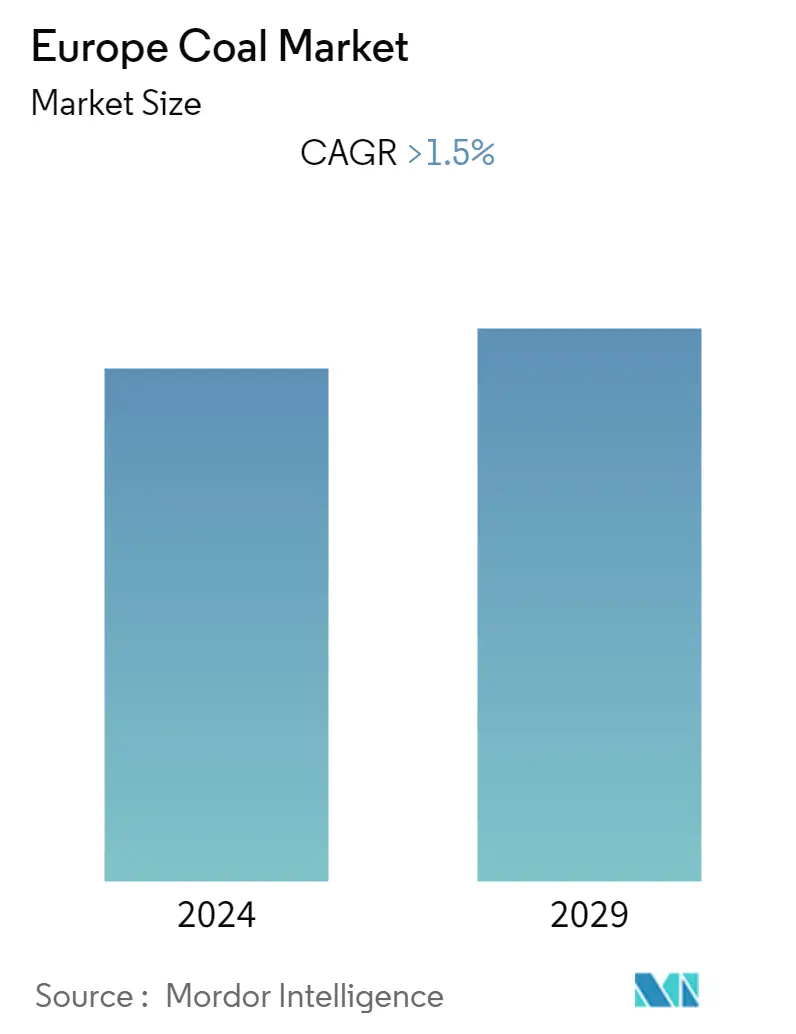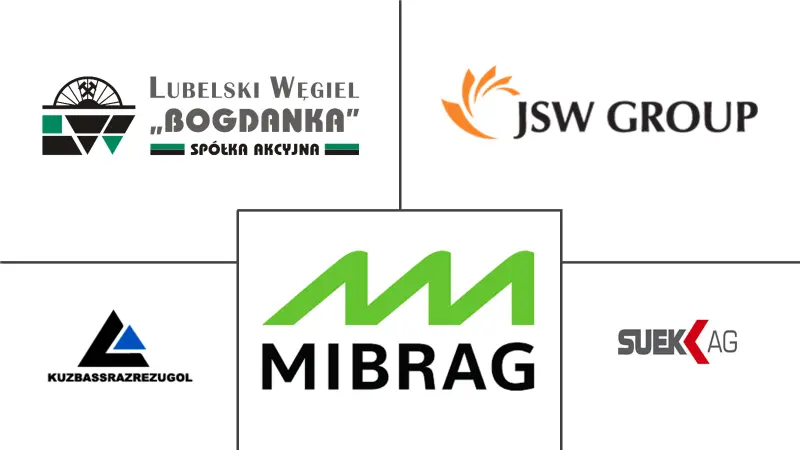Market Size of Europe Coal Industry

| Study Period | 2019 - 2029 |
| Base Year For Estimation | 2023 |
| Forecast Data Period | 2024 - 2029 |
| Historical Data Period | 2019 - 2022 |
| CAGR | > 1.50 % |
| Market Concentration | Low |
Major Players
*Disclaimer: Major Players sorted in no particular order |
Europe Coal Market Analysis
The European coal market is expected to register a CAGR of more than 1.5% during the forecast period.
The outbreak of COVID-19 had a negative effect on the market.The market has currently reached pre-pandemic levels.
- Factors such as increasing demand for steel production are likely to drive the market. Also, the electricity sector is expected to be the largest user of coal during the forecast period. As many countries are still trying to build new coal-fired power plants, especially in Eastern Europe, where cheap electricity is required, the presence of coal basins like the Donetsk basin is expected to drive the market.
- But a move away from coal-based power generation and efforts to use less coal in different end-user applications across the region are likely to slow the growth of the studied market.
- New technologies, like "clean coal," are expected to make coal better for the environment and lower the cost of the electricity it makes. This is likely to make the fuel more reliable and give market players a chance to make money.
- Russia is expected to be the biggest market for coal in the region because it uses and makes the most coal and because more money is being put into the mining industry there.
Europe Coal Industry Segmentation
Coal is a combustible black or brownish-black sedimentary rock with a high amount of carbon and hydrocarbons that forms as rock strata. The main types of coal are bituminous coal and sub-bituminous coal. Sub-bituminous coal is a type of coal that is gray-black or dark brown in color and varies in hardness from hard to soft because it is an intermediate stage between low-quality lignite and higher-quality bituminous coal. The European coal market is segmented by type, application, and geography. By type, it is segmented into anthracite, bituminous, sub-bituminous, and lignite. By application, the market is segmented into electricity, steel, cement, and others. The report also covers the size and forecasts of the coal market across the major countries in the region. For each segment, market sizing and forecasts have been done based on revenue (USD billion).
| Type | |
| Anthracite | |
| Bituminous | |
| Sub-Bituminous | |
| Lignite |
| Application | |
| Electricity | |
| Steel | |
| Cement | |
| Other Applications |
| Geography | |
| Russia | |
| Germany | |
| Poland | |
| Rest of Europe |
Europe Coal Market Size Summary
The European coal market is experiencing a gradual recovery, having reached pre-pandemic levels after the negative impact of COVID-19. The market is projected to grow steadily, driven by increasing demand for steel production and the electricity sector's reliance on coal. Eastern Europe, with its coal basins like the Donetsk basin, is expected to see continued investment in new coal-fired power plants to meet the demand for affordable electricity. However, the transition away from coal-based power generation and efforts to reduce coal usage in various applications may temper the market's growth. Innovations such as "clean coal" technologies are anticipated to enhance the environmental viability and cost-effectiveness of coal, potentially offering new opportunities for market players.
Russia is poised to be a dominant force in the European coal market due to its substantial production and investment in the mining sector. The country benefits from low production costs and strategic proximity to major importers like China and South Korea, which are significant consumers of Russian coal. Despite a general decline in coal consumption and production across Europe, countries like Poland and Germany continue to be major users, particularly of hard coal, which is essential for the electricity sector. The market remains partially fragmented, with key players such as Suek AG and Jastrzębska Spółka Węglowa SA actively participating. Recent developments, including the expansion of coal mines and the reactivation of coal power plants in Germany, indicate a complex landscape where coal remains a significant, albeit challenged, energy source.
Europe Coal Market Size - Table of Contents
-
1. MARKET OVERVIEW
-
1.1 Introduction
-
1.2 Market Size and Demand Forecast, in USD billion till 2028
-
1.3 Recent Trends and Developments
-
1.4 Government Policies and Regulations
-
1.5 Market Dynamics
-
1.5.1 Drivers
-
1.5.2 Restraints
-
-
1.6 Supply Chain Analysis
-
1.7 Porter's Five Forces Analysis
-
1.7.1 Bargaining Power of Suppliers
-
1.7.2 Bargaining Power of Consumers
-
1.7.3 Threat of New Entrants
-
1.7.4 Threat of Substitute Products and Services
-
1.7.5 Intensity of Competitive Rivalry
-
-
-
2. MARKET SEGMENTATION
-
2.1 Type
-
2.1.1 Anthracite
-
2.1.2 Bituminous
-
2.1.3 Sub-Bituminous
-
2.1.4 Lignite
-
-
2.2 Application
-
2.2.1 Electricity
-
2.2.2 Steel
-
2.2.3 Cement
-
2.2.4 Other Applications
-
-
2.3 Geography
-
2.3.1 Russia
-
2.3.2 Germany
-
2.3.3 Poland
-
2.3.4 Rest of Europe
-
-
Europe Coal Market Size FAQs
What is the current Europe Coal Market size?
The Europe Coal Market is projected to register a CAGR of greater than 1.5% during the forecast period (2024-2029)
Who are the key players in Europe Coal Market?
Suek AG, UK Kuzbassrazrezugol OAO, Mitteldeutsche Braunkohlengesellschaft mbH (MIBRAG), Lubelski Wegiel Bogdanka SA and Jastrzębska Spółka Węglowa SA are the major companies operating in the Europe Coal Market.

